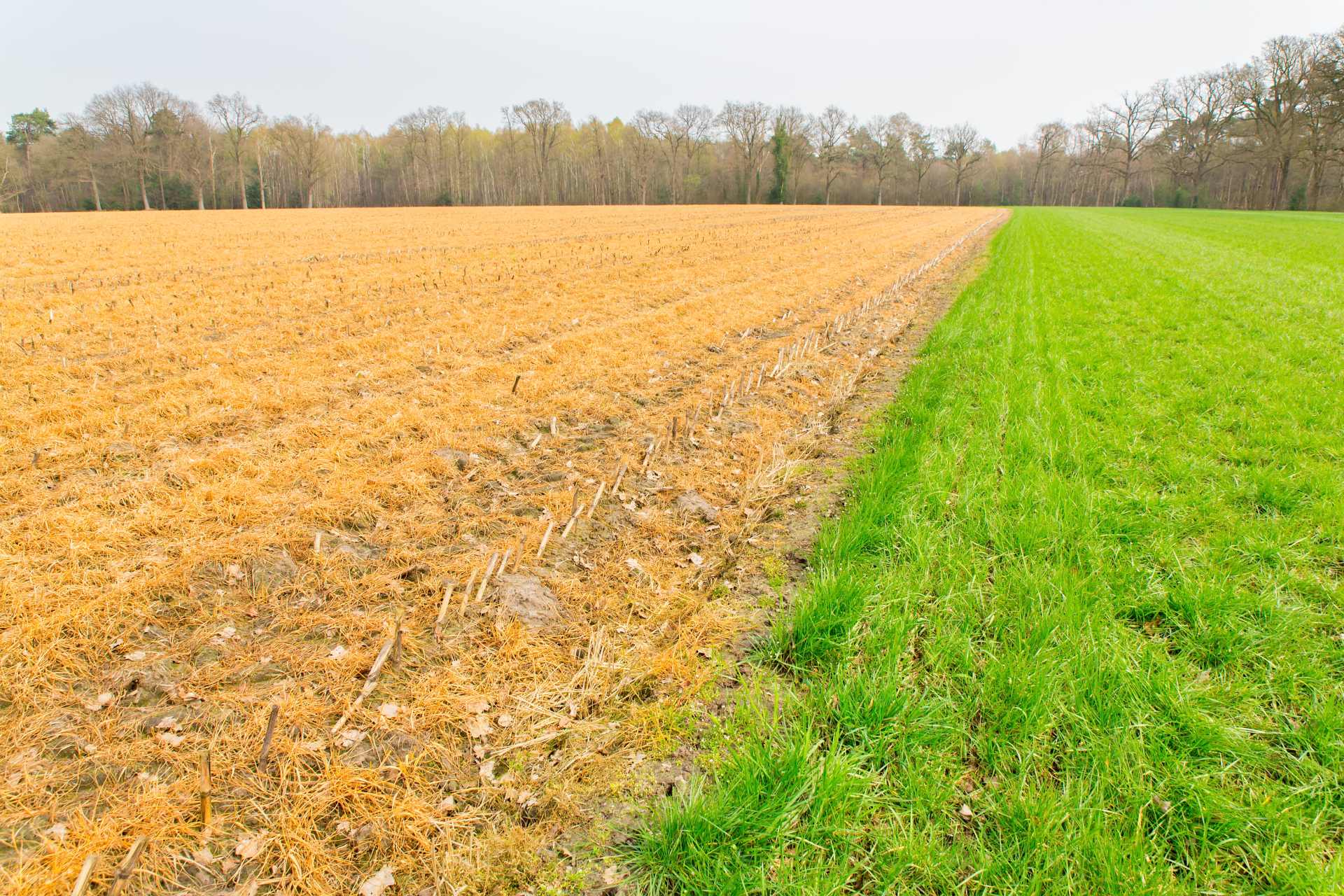Glyphosate is everywhere in our land-use systems — but where does it actually go after we spray it?
We’ve been told for decades that glyphosate binds tightly to soil and stays put. But does it always? And does binding automatically mean harmless?
A Massey University Master’s thesis by Jesús Adalberto Jiménez-Torres (2019) examined exactly that — in New Zealand soils, under New Zealand conditions. It looked at how glyphosate behaves after application: whether it moves, how it interacts with different soil types, how it affects non-target organisms like white clover and soil microbes, and whether some natural amendments (like Agave leaf material) might reduce its availability.
This matters because most conversations focus on above-ground residues — what’s on cereals, what ends up in honey or bread, what shows up in breakfast bowl testing. But below-ground behaviour is just as critical. If glyphosate can shift — even modestly — then our assumptions about where it ends, and how long it persists, need re-examining in the New Zealand context.
So what does the New Zealand data actually say?
The short version (if you only read one section)
Glyphosate can move: Depending on soil type and competing ions (like phosphate), glyphosate can be displaced from soil particles and migrate downward—raising leaching risk under certain conditions. That challenges the old assumption that glyphosate is always tightly bound and immobile.
Non-target organisms are affected: The thesis reports effects on soil microorganisms and white clover, a cornerstone species for New Zealand pasture systems. That’s not just a biodiversity issue; it can touch farm productivity and soil function.
Remediation shows promise: An exploratory Agave-based amendment was tested as an in-situ aid for enhancing degradation or reducing bioavailability—offering a potentially constructive path forward that merits field-scale trials.
Bigger picture: Newer studies internationally complicate the “all good if used as directed” narrative—particularly around long-term carcinogenicity signals at doses regulators long considered safe—while NZ’s regulatory regime still treats glyphosate as business-as-usual.
What the New Zealand thesis actually did (and found)
Design & soils: The research tested glyphosate behavior across three contrasting New Zealand soils, looking at adsorption/desorption (how strongly glyphosate binds, and how easily it can be knocked off and move), column leaching (a proxy for downward migration), effects on soil microbes and plant responses, and a remediation concept using Agave material to influence glyphosate’s fate. This multi-pronged approach is valuable because glyphosate’s “story” is more than a single lab test—it’s chemistry + biology + hydrology + time.
1) Mobility: not locked up 100% of the time
Glyphosate often binds to iron/aluminum oxides and clay minerals, which led to the longstanding belief that it hardly moves. But competing anions (notably phosphate) can displace it. The New Zealand work shows soil-specific variability: in some scenarios, glyphosate can be mobilised and leach—especially where phosphate levels are high, organic matter is low, or rainfall/irrigation patterns accelerate percolation. That finding aligns with earlier reviews warning that glyphosate in runoff and the root zone can contact non-target plant roots and aquatic systems.
Why that matters for New Zealand: We are a country of contrasting soils and intense rainfall events. Pasture systems are phosphorus-managed, and (until MPI’s 30 October 2025 decision) pre-harvest desiccation on food crops intended for human consumption was common practice during wetter months — although glyphosate pre-harvest use on animal-feed crops still remains permitted.
The take-home is not “massive leaching everywhere,” but a sober reality: under the wrong conditions, movement happens—and assuming perfect immobility can undercut water-quality protection.
2) Non-target hits: microbes and clover
The thesis reports impacts on soil microorganisms—the very life that cycles nutrients, builds soil structure, and supports carbon sequestration. It also identifies effects on white clover, a lynchpin of New Zealand’s low-nitrogen, pasture-based model. If root-zone glyphosate reaches clover, the plant can be stressed despite never being directly sprayed. For farmers, that is a productivity and resilience issue, not just an environmental one.
3) A constructive angle: Agave amendments
Rather than ending with “it’s bad,” the work pilot-tests Agave leaf material as a soil amendment to shift glyphosate availability and potentially enhance bioremediation. It’s early-stage science, not a commercial solution, but it points to feasible, nature-inspired interventions. A 2025 follow-on paper indicates continuing interest in Agave-based strategies to enhance phosphate desorption and support glyphosate attenuation in soils. That’s the kind of creative NZ-grown thinking we need.
How this fits with the wider, newer evidence
Long-term health signals: still contested, increasingly concerning
In 2025, a large, multi-arm two-year rat study reported dose-related increases in multiple benign and malignant tumors at exposures corresponding to the EU’s ADI (0.5 mg/kg/day) and NOAEL (50 mg/kg/day). While animal results don’t automatically translate to human risk, early leukemia deaths and cross-organ tumor findings at “allowed” doses merit precaution—especially given ubiquitous environmental presence.
Regulatory positions remain mixed: EFSA’s 2023 review supported renewal with data gaps; the U.S. EPA’s “not likely carcinogenic” stance was judicially vacated for re-work; New Zealand’s EPA continues to regulate glyphosate as a hazardous substance without a comprehensive, New Zealand-context reassessment of full formulations (active + co-formulants). None of that screams “settled science.”
Soil/water interface: a blind spot with consequences
A classic review on glyphosate in runoff and root-zones highlighted how non-target plants (including crops and pasture species) can uptake glyphosate from the soil solution—consistent with the Massey thesis’ concerns. If we ignore those belowground pathways, we risk underestimating impacts on plant communities and aquatic ecosystems.
Real-world translation for NZ
Pre-harvest use (desiccation) on small grains and legumes has historically intersected with rainfall, harvest timing, and soil texture — all of which can shift leaching risk and residue profiles in food. MPI has now announced that glyphosate pre-harvest desiccation on food crops intended for human consumption will be prohibited from 30 October 2025.
But this decision does not apply to animal-feed crops — and New Zealand Food Safety has simultaneously signalled higher MRLs on certain commodities. That only widens the tension between regulatory limits and real-world exposure.
Pasture renewal and spot-spraying near waterways could magnify local vulnerability, especially where soils are sandy/volcanic or phosphate levels are high.
Obvious question: “If EFSA renewed glyphosate, isn’t it fine?”
EFSA’s 2023 conclusion is not a blanket “safe forever” rubber-stamp. It explicitly identifies data gaps and methodological limits—particularly around co-formulants, endocrine-disrupting potential, and biodiversity endpoints—leaving Member States to mitigate risks and plug gaps. Renewal under uncertainty is not the same as proof of no harm. Meanwhile, U.S. courts told EPA to revisit its human-health conclusions. Disagreement at the top should drive more NZ-specific research and monitoring, not less.
What this means for New Zealand decision-makers
- Stop assuming soil immobility. The New Zealand data show that phosphate competition and soil properties can displace glyphosate. Our freshwater and estuaries already face cumulative stressors; adding a mobile, chelating herbicide into the mix—especially near drains and streams—makes conservative buffers and no-spray zones common sense.
- Protect pasture function. White clover is foundational to our pasture economics and climate profile (biological nitrogen fixation). Policies should minimise root-zone exposure and support farm systems that reduce reliance on “spray-renovate” cycles where possible.
- Assess formulations, not just the active. Real-world products are mixtures. New Zealand should reassess glyphosate formulations (co-formulants included), not only the active ingredient in isolation, and align with up-to-date science on chronic endpoints (including endocrine, mitochondrial, and carcinogenic signals).
- Fund New Zealand field trials and monitoring. Lab and greenhouse data need catchment-scale confirmation: tile drains, ephemeral streams, storm events, and soil series matter. National-scale monitoring for glyphosate + AMPA in soils/sediments and small waterways is overdue.
- Support remediation R&D. The Agave-based concept is a positive pathway worth exploring alongside microbial and phytoremediation options. Direct some public R&D toward in-situ mitigation for hotspots (farm tracks, yards, headlands, riparian margins).
What farmers and councils can do now (practical steps)
- Prefer mechanical/thermal controls where feasible, especially near drains, culverts, and riparian areas.
- If you must spray, avoid wet weather windows and keep phosphate fertiliser applications separate from glyphosate use when possible to reduce displacement pressure in the soil profile.
- Expand buffer widths beyond the legal minimum in vulnerable soils.
- Trial clover-friendly rotations and reduce whole-paddock knockdowns; prefer targeted spot-treatments away from clover-rich swards.
- Participate in monitoring: If you have drains/streams, periodic testing for glyphosate and AMPA can guide smarter practices and demonstrate stewardship.
Addressing the usual pushback (briefly)
- “Glyphosate binds tightly; it can’t move.” Often, but not always. New Zealand research shows soil-dependent mobility and phosphate-mediated displacement. That’s exactly what risk management should account for.
- “Regulators renewed it; end of story.” Not quite. EFSA renewed with data gaps; the U.S. EPA’s human-health review was vacated for reconsideration. Scientific debate continues—and so should NZ vigilance.
- “Animal studies aren’t humans.” True—but they are the bedrock of hazard detection. Newer chronic studies at regulatory-relevant doses should raise eyebrows, spur exposure reduction, and prompt better human biomonitoring.
Where to now?
The Massey thesis is a gift: practical, New Zealand-specific evidence that glyphosate’s footprint doesn’t end at the spray line. It can shift in soils, reach roots, and nudge microbial communities—the invisible workforce our land depends on. Couple that with new long-term toxicology signals and a still-divided regulatory picture, and the prudent path is clear: use less, use smarter, monitor more, and invest in alternatives.
If New Zealand wants a resilient, high-value food system, we should not be writing our environmental policy in spray diaries. Let’s invest in New Zealand field science, remediation pilots, and policies that protect the very soils that feed us.
Resources & References
If you’d like to dig deeper, the following sources give shape to this picture — and show why glyphosate’s below-ground story is more complex than we’ve been told.
Glyphosate displacement from New Zealand soils and its effect on non-target organisms
Jiménez-Torres, JA (2019)
(Massey University thesis).
New Zealand-specific study on sorption/desorption, column leaching, microbial and clover effects, and a pilot Agave remediation concept. Download the full thesis.
Glyphosate in Runoff Waters and in the Root-Zone: A Review.
Saunders LE et al. (2015)
Classic review highlighting how root-zone exposure matters and how non-target plants can encounter glyphosate from soil water.
Carcinogenic effects of long-term exposure from prenatal life to glyphosate and GBHs in SD rats.
Panzacchi S. et al. (2025)
Environmental Health.
A 2-year rat study reporting dose-related tumor increases at exposures aligned with EU ADI and NOAEL. Strong hazard signal, still debated.
Peer review of the pesticide risk assessment of glyphosate.
EFSA (2023).
EU renewal with data gaps and conditions; not a free pass. Useful overview of endpoints and uncertainties.
Opinion vacating EPA’s human-health portion of the glyphosate interim decision.
U.S. Ninth Circuit (2022)
NRDC v. EPA
Court held EPA’s analysis inconsistent and sent it back for further work—underscoring that the science/policy is not settled.
Glyphosate: rules and regulation (web guidance).
NZ EPA.
Baseline page explaining New Zealand’s hazardous-substances framework for glyphosate-containing products.
Agave leaf powder enhances phosphate desorption and potential glyphosate bioremediation (abstract).
Jiménez-Torres JA (2025)
Signals ongoing research interest in nature-based soil amendments for mitigation.
NZ Food Safety proposes increasing residue limits…
NZ Herald (2025)
Media coverage of proposed MRL increases, relevant to pre-harvest use and exposure debates in New Zealand.
Reading these papers side-by-side, one theme becomes hard to ignore: the closer the research gets to real soils, real roots, and real systems — the less comforting the old assumptions become.
Image Source & Attribution
The image featured on this page is from Depositphotos and credited to the photographer benschonewille.




